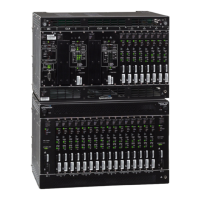14
TimeHub 5500 TL1 Reference Manual
Introduction
097-55501-02 Issue 5: June 2003
SSS SSSSSSS SSSS S SSSSS SSSSSSS S SSS S SSSSS SS
1
Security
If security is enabled, a user is required to log on to the system before entering TL1
commands. If disabled, logging on is not required.
<pid> Password identifier Password for logging into the system. Up to ten case-sensitive
characters. Must include at least two non-alphabetic characters, and
must include at least one special character: any printing character other
than a letter of the alphabet, a number, a comma, a colon, or a
semicolon.
<sid> Source identifier Name of the equipment sending the message. May be 1 to 20
alphanumeric characters.
<spec block> Specification block Holds a number of parameters within the command.
<srveff> Service affecting Identifies whether the alarm condition is service affecting:
SA = service affecting
NSA = not service affecting
<start retrieving
messages>
Start retrieving
messages
Specifies which portion of the event log is retrieved:
EVTTOP = retrieves 10 most recent messages from the top of the
log
EVTCON = continues to retrieve messages from where last left off
EVTALL = retrieves all messages
<tid> Target identifier Identifies the equipment (TimeHub 5500) to which the command is
directed. Must be a valid TL1 identifier of a maximum of 20 characters
(limited to letters, digits, and hyphens). The <tid> value may be null.
<time> Time Current time in the six-digit form: hh-mm-ss (command) or hh:mm:ss
(response or message), where hh is hours (00 to 23), mm is minutes (00
to 59), and ss is seconds (00 to 59). For example, 5:11:49 a.m. is
05:11:49.
<uap> User access level Used by a system administrator to assign a given level of access to
system users. User access levels are USER, ADMIN, or SECURITY, with
USER being the lowest access level and SECURITY being the highest
access level.
<uid> User identifier Name for logging into the system. Contains up to 10 alphanumeric,
case-insensitive characters provisioned as valid login IDs.
<value> Value Used in conjunction with other blocks in a command to specify a value
(for example, <keyword>=<value>).
Table A. Parameter Definitions (cont’d)
Parameter Definition Use

